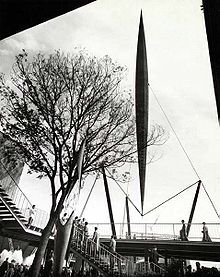Skylon (Festival of Britain)



TheSkylonwas a futuristic-looking, slender, vertical, cigar-shapedsteeltensegritystructure located by theThamesinLondon,that gave the illusion of floating above the ground, built in 1951 for theFestival of Britain.
A popular joke of the period was that, like the British economy of 1951, "It had no visible means of support".[1]
Construction
[edit]The Skylon was the "Vertical Feature" that was an abiding symbol of the Festival of Britain. It was designed byHidalgo Moya,Philip PowellandFelix Samuely,and fabricated byPainter BrothersofHereford,England,on London'sSouth BankbetweenWestminster BridgeandHungerford Bridge.The Skylon consisted of a steellatticeworkframe, pointed at both ends and supported on cables slung between three steel beams. The partially constructed Skylon was rigged vertically, then grew taller in situ.[2]The architects' design was made structurally feasible by the engineer Felix Samuely who, at the time, was a lecturer at theArchitectural Association School of Architecturein Bedford Square, Bloomsbury. The base was nearly 15 metres (50 feet) from the ground, with the top nearly 90 metres (300 feet) high. The frame was clad in aluminium louvres lit from within at night. Questions were asked inParliamentregarding the danger to visitors from lightning-strikes to the Skylon, and the papers reported that it was duly roped off at one point, in anticipation of a forecast thunderstorm.[3]
Name
[edit]Both the name and form of the Skylon most likely referenced theTrylonfeature of the1939 New York World's Fair.[4]The name was suggested by Mrs A. G. S. Fidler, wife of the chief architect of theCrawley Development Corporation.[5]Moya wrote, "We were unimpressed at first but soon came to accept that, by combining the suggestions of Pylon, Sky and Nylon (a fascinating new material in 1951), it was wonderfully descriptive name which has lasted forty years, considerably longer than the structure itself."[6]
Incidents
[edit]A few days before the King and Queen visited the exhibition in May 1951, Skylon was climbed at midnight by Philip Gurdon, a student atBirkbeck College,who attached aUniversity of LondonAir Squadronscarf near the top. Police constable Frederick Hicks was sent up to retrieve the scarf the following morning.[7]
Demolition
[edit]In spite of its popularity with the public, the £30,000 cost of dismantling and re-erecting the Skylon elsewhere (equivalent to £800,000 as of 2023)[8]was deemed too much for a government[9]struggling with post-warausterity.Skylon was removed in 1952 when the rest of the exhibition was dismantled, on the orders ofWinston Churchill,who saw the Festival and its architectural structures as a symbol of the preceding Labour Government's vision of a new socialist Britain.[10][11]
Speculation as to the Skylon's fate included theories fromJude Kelly,artistic director of the Southbank Centre, that it was thrown into theRiver Leain east London, dumped into the Thames, buried underJubilee Gardens,[12]made into souvenirs or sold as scrap. The base is preserved in the Museum of London and the wind cups are held in a private collection.[13]An investigation was carried out by theFront Rowprogramme onBBC Radio 4and the result was broadcast on 8 March 2011. It was revealed that the Skylon and the roof of the Dome of Discovery had been sold toGeorge Cohen, Sons and Companyscrap metal dealers of Wood Lane,Hammersmith,and dismantled at their works in Bidder Street,Canning Town,on the banks of theRiver Lea.Some of the metal fragments were then made into a series of commemorativepaper-knivesand other artefacts. The inscriptions on the paper-knives read "600"[Note 1]and "Made from the aluminium alloy roof sheets which covered the Dome of Discovery at the Festival of Britain, South Bank. The Dome, Skylon and 10 other buildings on the site, were dismantled by George Cohen and Sons and Company Ltd during six months of 1952."[14]
The former location of the Skylon is the riverside promenade between theLondon EyeandHungerford Bridge,alongside theJubilee Gardens(the former site of theDome of Discovery).
2007 Skylon restaurant
[edit]In May 2007D&D London(formerly Conran Restaurants) opened a new restaurant named Skylon on the third floor of theRoyal Festival Hall.This restaurant had previously been named The Peoples Palace.
See also
[edit]Notes
[edit]References
[edit]- Articles fromThe Timesbetween 1951 and 1952
- ^"The Reunion – Festival of Britain".BBC Radio 4.
- ^Henry Grant."The Skylon in construction".Museum of London.Archived fromthe original(photo)on 30 July 2013.
- ^"Ropes round the Skylon".The Guardian.19 May 1951. p. 5.Retrieved1 February2021.– via newspapers.com(subscription required)
- ^The Metropolitan Museum of Art, NYC, Great Britain and Ireland 1900 AD-present, 1951,
- ^The Times,Saturday, Nov 11, 1950
- ^Hidalgo Moya, "Rebuild the Skylon!"Archived2009-01-06 at theWayback Machine
- ^"Skylon, Festival of Britain centrepiece, and Hereford", BCC, 25 February 2011
- ^UKRetail Price Indexinflation figures are based on data fromClark, Gregory (2017)."The Annual RPI and Average Earnings for Britain, 1209 to Present (New Series)".MeasuringWorth.Retrieved7 May2024.
- ^TheLabour Partywho had been in government since July 1945, lost thegeneral election in October 1951.
- ^Skyscraper news,
- ^Glancey, Jonathan (9 July 2008)."Skylon: is there a point in rebuilding it?".The Guardian.London.Retrieved16 September2012.
- ^Brown, Mark (19 January 2011)."Skylon's the limit for Festival of Britain rerun".The Guardian.London.
- ^Singh, Anita (20 January 2011)."Festival of Britain: divers to search for missing Skylon".The Telegraph.London.Retrieved8 March2011.
- ^BBC Radio 4, Front Row, Skylon investigation
External links
[edit] Media related toSkylon, Londonat Wikimedia Commons
Media related toSkylon, Londonat Wikimedia Commons- Skylon spire may return to London skyline(The Guardian)
- The Skylon
- Museum of Londoncolour photo of the Skylon
